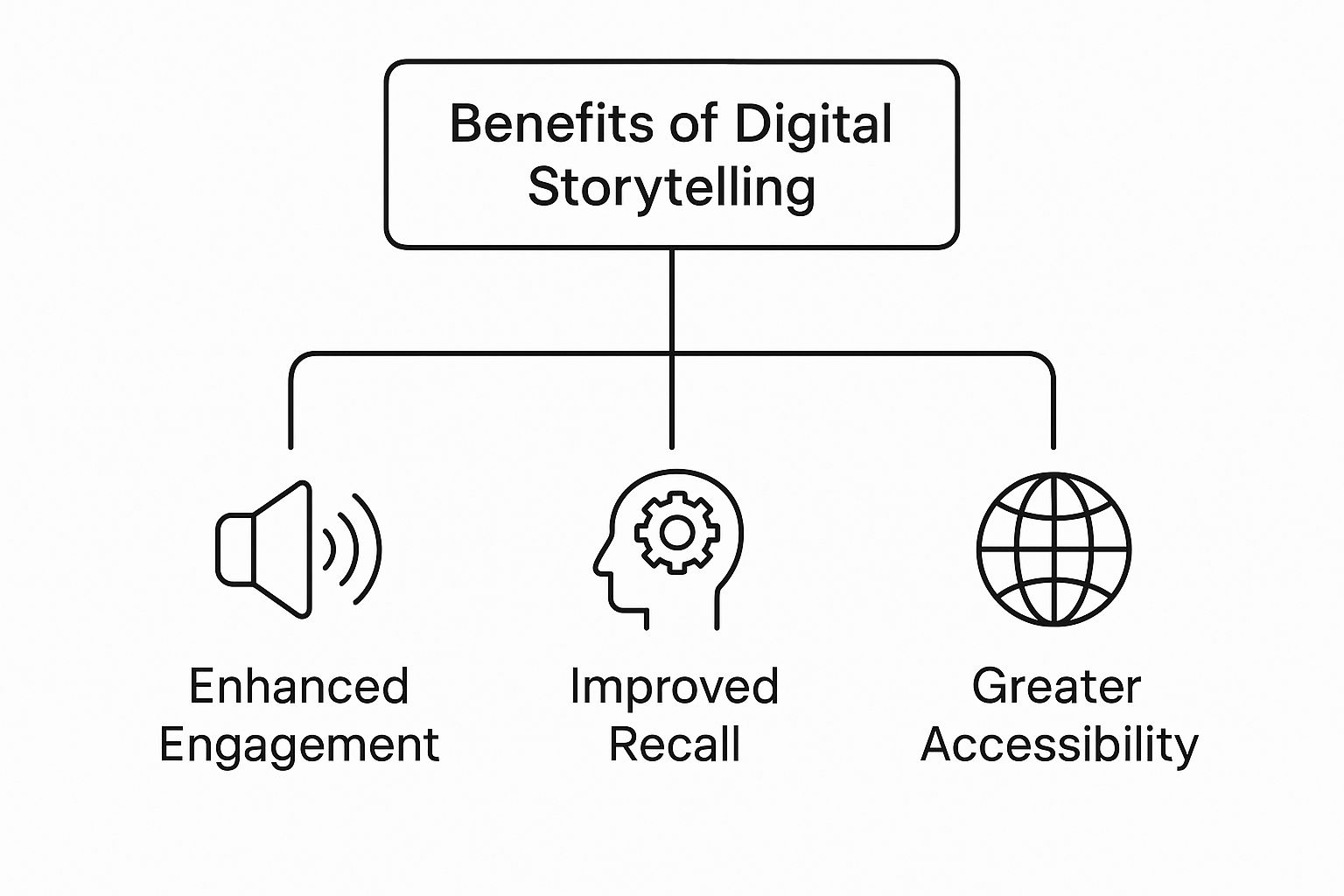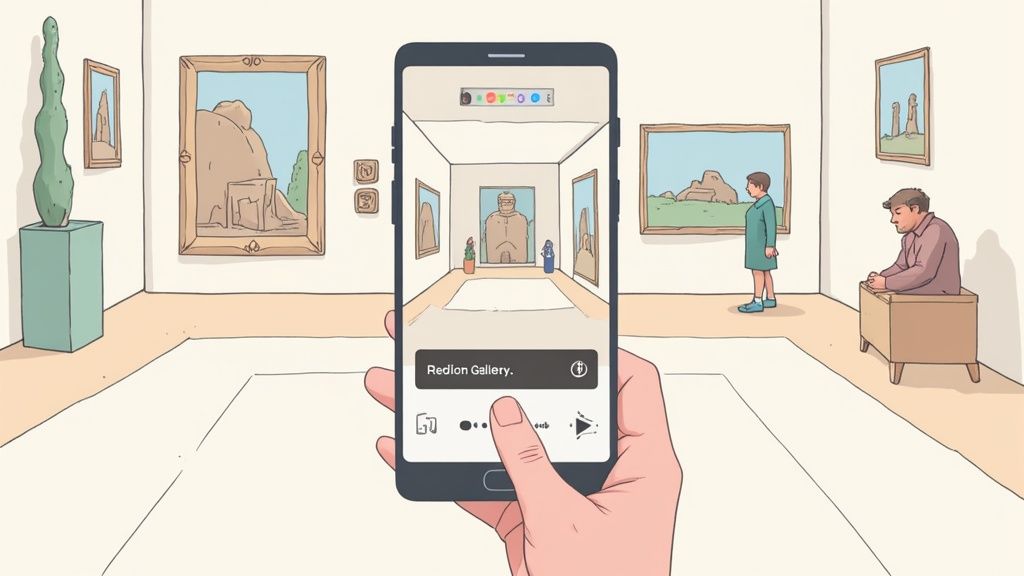What Is Digital Storytelling And How It Works

So, what is digital storytelling, really? It’s what happens when you take the ancient art of telling a good story and power it up with today’s tools—think video, sound, and interactive graphics. Imagine the classic campfire story, but now it’s rebuilt for a world where anyone can see, hear, and even interact with the narrative from anywhere.
The New Age of Digital Narratives

Digital storytelling is so much more than just putting words on a screen. It’s about weaving together our timeless human need to share experiences with the incredible potential of technology. Instead of just pushing a message out, you’re creating a full-sensory experience that connects with people on a much deeper, more emotional level.
This isn’t about passive consumption anymore. A great digital story pulls people in, making them active participants. It doesn't just tell you something; it invites you to step into a world, whether that's through an interactive infographic, an immersive video, or a podcast that makes you feel like you're right there in the room.
From Side Project to Global Industry
What started in the early 2000s with a few simple blogs has absolutely exploded. What was once a niche practice is now a massive, multi-billion-dollar industry, and it's all thanks to the sheer number of people online.
To put it in perspective, by the start of 2025, we're looking at an estimated 5.56 billion internet users globally. That’s nearly 68% of the world's population. This huge audience has fueled the growth of digital storytelling platforms, which are valued at $10 billion in 2024 and are on track to hit $30 billion by 2032, growing at a 15% clip each year. You can dive into the full dataset in the latest global digital overview report.
This shift shows a fundamental change in how we connect. Brands, educators, and creators now have the tools to build real relationships and make complex ideas not just understandable, but truly memorable.
What makes these stories so powerful? It boils down to a few key ingredients:
- Emotional Connection: Using visuals, music, and sound to create feelings that plain text just can't touch.
- Multimedia Integration: Layering video, images, text, and audio to build a rich, textured experience.
- Interactivity: Giving the audience a role to play, whether it’s by making a choice, clicking a button, or joining the conversation.
Digital storytelling isn't just about the tech. It's about using that tech to amplify the most human part of us: our need to share stories that create meaning and connection.
As you get deeper into digital storytelling, you'll find specialized skills are crucial. For instance, audio isn't just background noise; it's a powerful tool for shaping the entire experience. To get a handle on this, check out this fantastic guide on What is sound design, a guide to audio storytelling—it really breaks down how sound drives emotion and perception.
The Core Elements of A Powerful Digital Story
So, what separates a truly memorable digital story from all the other noise out there? It’s not just one thing. It's a careful blend of specific ingredients that work together to create a powerful, immersive experience.
Understanding these core elements is the first step. This is how you move beyond just creating content and start crafting narratives that genuinely connect with people.
Building An Emotional Bridge
At the very heart of any great story is its central narrative. This is the backbone, the core message or plot that holds everything else together. It needs a clear beginning, a compelling middle, and a satisfying end that leaves a lasting impression.
Without that solid foundation, even the most dazzling visuals or slick interactive features will feel disconnected and ultimately fall flat.
Once you’ve got your narrative down, the next crucial step is forging a genuine emotional connection. This is what makes people care. Stories have an incredible power to move us, and digital tools amplify this by using visuals, music, and personal accounts to spark empathy, joy, or curiosity.
The most effective digital stories don't just present information; they make the audience feel something. This emotional resonance is what transforms passive viewers into an engaged community.
This is especially true in business and education. The impact is undeniable when you see that a mere 5% boost in customer retention from narrative-driven experiences can increase profits by up to 25%. In education, multimedia narratives are improving student comprehension by as much as 20% compared to traditional teaching methods.
Choosing Your Creative Toolkit
With a strong story and an emotional hook, you can then pick the right multimedia elements to bring it all to life. This isn't about throwing every tool you have at the wall to see what sticks; it’s about making smart, strategic choices.
- Video and Animation: Fantastic for showing action and conveying complex emotions in a short amount of time.
- Audio and Music: Sets the mood and can create a deeply immersive atmosphere, sometimes even more powerfully than video.
- Images and Graphics: Can instantly communicate ideas and break up text, making your story much easier to digest.
This diagram shows how these elements combine to produce tangible benefits.

As you can see, things like higher engagement, better memory recall, and greater accessibility are all direct results of well-executed digital storytelling.
The final, game-changing components are interactivity and distribution. Interactivity flips the script from a one-way message to a two-way conversation, letting users make choices or explore content on their own terms. And choosing the right platform—whether it's Instagram, a blog, or an interactive video tool like Lumeo—ensures your story actually gets in front of the right people.
Mastering these elements involves specific skills. For a deeper dive, explore these practical https://www.lumeo.me/en/blog/visual-storytelling-techniques. To truly elevate your craft, it's also crucial to understand specific video storytelling techniques that captivate and hold an audience's attention.
Why Digital Storytelling Drives Business Growth

In a marketplace flooded with noise, the brands that truly connect aren't the loudest—they're the ones with the most compelling story. Digital storytelling cuts through the clutter of generic marketing claims to build something far more powerful than fleeting attention: a genuine human connection.
That connection is the real secret to brand loyalty. When customers feel like they're part of your brand's journey, they stop being one-time buyers and start becoming dedicated advocates. A great story doesn't just sell a product; it sells a purpose and invites people to join in.
This emotional bond has a direct impact on your numbers, boosting engagement across every channel you use. Websites and social media profiles that lean into storytelling see people stick around longer, share more often, and leave more meaningful comments.
Making The Complex Compelling
One of the biggest wins for digital storytelling in business is its power to make complicated products or services feel simple and relatable. Let's be honest, a technical spec sheet is informative, but it's rarely going to get anyone excited. A story, on the other hand, can turn abstract features into tangible solutions.
Just look at the difference:
- Generic Description: "Our software features a proprietary algorithm for advanced data analysis."
- Digital Story: "Meet Sarah, a small business owner drowning in data. Watch how our software helped her find a game-changing trend in 30 seconds, saving her business."
The story immediately gives context, creates empathy, and shows the product working in the real world. Suddenly, its value is crystal clear. This approach helps your audience actually see themselves succeeding with your product, which is a massive push toward making a purchase.
By framing a product as the solution within a customer's own story, you're not just selling a tool; you're selling a transformation. This shift in perspective is what elevates marketing from a transaction to a relationship.
Ultimately, it’s all about showing, not just telling. When you illustrate a customer's problem and how you helped solve it, you build trust and prove your impact. This narrative-driven strategy is one of the most effective ways to boost conversions and drive sustainable growth, turning your marketing into something people actually want to see.
Inspiring Examples of Digital Storytelling Done Right
Knowing the theory is one thing, but seeing digital storytelling in action is where it all really clicks. The best way to get a feel for its true power is to look at how real organizations have woven together narrative, emotion, and technology to get incredible results. These examples prove that a well-told digital story can do just about anything, from driving donations to making complex ideas feel simple.
Let’s walk through a few different case studies to see how all those core elements we’ve talked about come together to build something memorable and effective. Each one offers a practical blueprint you can borrow for your own projects.
A Non-Profit's Poignant Documentary
Picture a small environmental non-profit that desperately needs to raise funds for a critical conservation project. Instead of just throwing a list of grim statistics at people, they created a short, emotional video documentary. The story followed a single researcher on their journey, capturing both the daily struggles and the small glimmers of hope in their work.
This approach worked because it forged a powerful emotional connection. Viewers weren't just being fed data; they were invited into someone's personal story, making the cause feel urgent and deeply human. By focusing on one person, the organization made a huge, abstract problem feel tangible and solvable. The result? They completely smashed their fundraising goals, boosting donations by over 300% compared to their old text-based campaigns.
A powerful narrative transforms abstract issues into personal missions. By focusing on a relatable human story, the non-profit gave its audience a clear reason to care and a hero to root for.
A B2B Firm Demystifying Complexity
Now, let's switch gears to a B2B tech firm selling sophisticated data analytics software. Their big hurdle was explaining a very technical product without making potential clients' eyes glaze over. A simple webpage listing features just wasn't doing the job. So, they built an interactive webpage that walked users through a simulated problem.
Visitors could click their way through a simplified scenario, making choices and seeing exactly how the software would analyze data at each turn. This strategy was a home run for a few key reasons:
- Interactivity: It turned passive readers into active participants, which made the whole learning process far more engaging.
- Simplicity: The story-based format broke a complex process down into bite-sized, digestible steps.
- Value Demonstration: It showed the software’s benefits in a real-world context instead of just telling people about its features.
This clever digital story took the mystery out of their product and led to a 40% increase in qualified leads from their website. The interactive narrative made the software's value crystal clear.
A Travel Company’s Immersive Social Stories
Finally, imagine a travel company trying to get people excited about a new destination. Instead of the usual glossy photos, they launched a week-long series of immersive stories on Instagram and TikTok. Every day, they shared short video clips, polls, and Q&A sessions that followed a travel blogger exploring the location in real-time.
The whole campaign felt authentic and immediate, giving followers a genuine peek into the experience. By collaborating with a popular influencer, they tapped into a ready-made community and built instant trust. This strategy showcased the destination’s highlights in a natural way, making viewers feel like they were right there on the adventure. This first-person narrative was far more convincing than any traditional ad and drove a massive spike in bookings.
For more great ideas, you can find a ton of other powerful storytelling in marketing examples that show how brands are winning hearts and minds.
The Future of AI and Immersive Narratives

The age-old craft of storytelling is getting a serious upgrade, and it's being powered by technology that’s completely reshaping how we create and consume stories. At the heart of this shift are two key players: Artificial Intelligence (AI) and immersive media. They're quickly moving from futuristic concepts to practical, powerful tools for creators everywhere.
Just imagine a story that adapts to your choices in real-time, where the plot shifts and characters react based on your emotions. That’s the incredible potential of AI-driven narratives. AI is no longer just for automating tasks; it’s becoming a genuine creative partner. To see how creators are already tapping into this, check out our guide to AI content creation tools.
The Rise of Intelligent and Immersive Worlds
It doesn't stop with AI. Immersive tech like Augmented Reality (AR) and Virtual Reality (VR) are tearing down the wall between the audience and the story itself. Once the exclusive playground of gaming, these tools now let brands and educators build entire worlds for their audiences to explore.
AR can lay digital information over the real world—picture taking a historical tour where ancient buildings are digitally reconstructed right on your phone’s screen. VR, on the other hand, drops you into a fully simulated environment, offering a complete escape into a new reality.
What's really happening here is a fundamental change in our relationship with stories. We’re moving from passively listening to a narrative to actively participating in it. The story becomes a personal, hands-on journey.
The growth in this space is staggering. The market for digital storytelling platforms was pegged at $415.78 million in 2024 and is on track to jump to $467.26 million in 2025. Looking ahead, it's projected to explode to over $1.1 billion by 2032. As these platforms weave in more advanced AI for scriptwriting and immersive features, they are paving the way for a new generation of deeply personal, interactive content. You can explore more on the market growth of digital storytelling platforms.
Alright, let's get into the nitty-gritty of how you actually make one of these things.
How To Create Your First Digital Story
Jumping into digital storytelling can feel like a massive project, but I promise it doesn't have to be. The trick is to break the whole thing down into smaller, more manageable steps. This way, you can go from a simple idea to a polished final product without getting completely overwhelmed.
Think of this as your roadmap. It all starts not with fancy software, but with two simple questions: What are you trying to do, and who are you talking to? A story only works if it connects with the right people.
Define Your Purpose and Audience
First things first. Before you even think about a camera or a design tool, you need to get laser-focused on your main goal.
Are you trying to drum up sales for a new product? Are you hoping to raise awareness for a cause you care about? Or maybe you just want to explain a complicated topic in a way that people will actually understand. Your purpose is your North Star—it will guide every decision you make from here on out.
Just as important is knowing your audience inside and out. What do they care about? What problems are they trying to solve? A story built for a group of busy executives is going to feel totally different from one made for a community of artists. You have to get inside their heads to create something that truly lands.
Craft Your Core Message
Once you know your "why" and your "who," you can start building the heart of your story: the core message. This is the one big idea you want people to walk away with.
A fantastic way to structure your narrative is to use the classic three-act arc. It's simple, powerful, and it just works.
- The Setup: Introduce your main character or the problem they're facing.
- The Conflict: Show the struggle, the journey, the challenge they have to overcome.
- The Resolution: Reveal the solution, the transformation, or the big win.
This simple framework gives your story a natural flow that keeps people hooked from the beginning all the way to the end.
Choose The Right Tools and Assets
Okay, now it's time for the fun part—bringing your story to life with visuals and sound. This is where you decide what form your story will take. Will it be a quick video? An interactive webpage? A carousel post for social media? The best format is simply wherever your audience already hangs out online.
After you've picked your format, you can start gathering the building blocks. This usually includes things like:
- Video clips and background footage (b-roll)
- High-quality photos or custom illustrations
- Music and sound effects that set the mood
- Text overlays and other graphics
Modern tools can make this part way easier than it used to be. For example, platforms like Lumeo are designed specifically to help you pull all these different pieces together into a professional-looking story, fast.
The whole point of an interface like this is to be intuitive. It lets pretty much anyone turn an article or a raw video clip into an engaging visual story, no advanced design degree required.
Don't forget the final—and most crucial—steps. Once your story is built, publish it on the platforms your audience uses most. Then, you have to actively promote it. Your job isn't done until your story has actually been seen.
Got Questions About Digital Storytelling? We’ve Got Answers.
Even after laying out the roadmap, a few questions always pop up. It’s completely normal. Here are some quick, no-fluff answers to the things people usually ask when they’re getting started.
What’s the Real Difference Between a Digital Story and Just a Regular Video?
It really boils down to two things: narrative structure and emotional intent.
Think about it this way: a basic marketing video might just show you a new drill and list its features. A digital story, on the other hand, introduces you to a character struggling to hang a family portrait, and that drill becomes the hero that solves their problem. It’s about creating an emotional arc—a beginning, a middle, and an end—that pulls people in and makes the message stick.
How Long Should a Digital Story Be?
There’s no magic number here. The perfect length really depends on where you’re posting it and who’s watching.
For fast-paced platforms like TikTok or Instagram Reels, you want to keep it snappy—under 60 seconds is your sweet spot. If you’re creating something more in-depth for your website or YouTube, you have more room to breathe, maybe two to five minutes. The golden rule is to hold their attention. Be as brief as you can be while still being impactful.
The best digital stories are long enough to make their point and not a second longer. In a world of short attention spans, getting to the point is your greatest strength.
Do I Really Need to Buy Expensive Equipment to Get Started?
Absolutely not. It’s a common misconception that you need a Hollywood budget. You can create something truly powerful with the smartphone in your pocket and some easy-to-use editing software.
The real power of your story isn't in the camera's price tag; it’s in the narrative itself and the connection you build. Just focus on getting clear audio and telling a compelling story. Some of the most viral and effective digital stories were built on simple, authentic visuals.
What’s the Single Most Important Part of Digital Storytelling?
If you take away only one thing, let it be this: authenticity.
Visuals are great, and the tech is cool, but your audience can tell when a story feels forced or fake from a mile away. It doesn't matter if you're a massive brand or a solo creator—your story has to feel real and true to who you are. That’s how you build trust, and trust is the bedrock of any lasting connection with an audience.
Ready to start turning your own ideas into stories that people can’t ignore? With Lumeo, you can easily transform articles, videos, and raw concepts into captivating carousels that stop the scroll and get results. Give it a try for free and see for yourself.